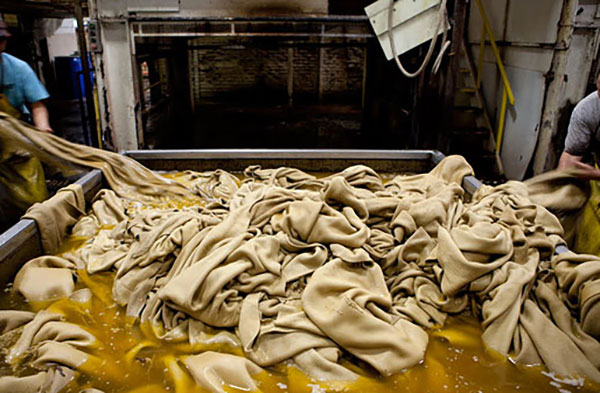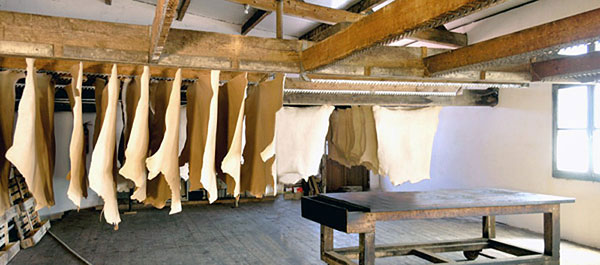People have used leather to make clothing, containers for carrying dry goods and liquids, harnesses, bridles, saddles, shoes and a multitude of other products for a very long time, indeed. Leather can be made of any type of skin or hide; however, some types of skins are better for one purpose than another. For example, water buffalo hide is better for making saddles than shoes because it is very thick and tough. The most often used hides are from domestic cattle and sheep or wild elk and deer.

In order to make leather soft and pliable for use, it must be put through a tanning leather process. This is a process that has been in use in one form or another for thousands of years. When you purchase leather goods, it’s smart to know how the leather was prepared. This is especially true for people who are very sensitive to chemicals. The leather is usually tanned in one of two ways. One is chrome tanning, and the other is vegetable tanning. In this article, we will compare and contrast these two methods.
- Why Leather Is Tanned
The reason for tanning leather is to change the skin or hide’s protein structure. Tanning arrests the decaying process and changes the skin into leather. Once tanning is complete, the leather can be used to create a wide variety of leather goods. The skins or hides of domestic animals generally make the best leather. The first step in tanning is to cure the skin by smoking, drying or salting it. Following this, excess flesh and hair are removed. After this, the skin must be washed and/or limed before it can be tanned. - What’s Good About Chrome Tanning??
 When chrome tanning is used, the leather will be soaked in a solution containing metal chromium. All but about twenty percent of animal hides tanned today are done so with this method. The technique can be altered in a variety of ways to create leather that is suitable for different uses. One good thing about chrome tanning is that it produces leather that is very water resistant. At the same time, the leather feels soft and can be dyed with a wide variety of colors. The colors tend to set well and stay vibrant with the passage of time. The chrome tanning leather process also produces leather that ensures heat better.
When chrome tanning is used, the leather will be soaked in a solution containing metal chromium. All but about twenty percent of animal hides tanned today are done so with this method. The technique can be altered in a variety of ways to create leather that is suitable for different uses. One good thing about chrome tanning is that it produces leather that is very water resistant. At the same time, the leather feels soft and can be dyed with a wide variety of colors. The colors tend to set well and stay vibrant with the passage of time. The chrome tanning leather process also produces leather that ensures heat better. - Problems With Chrome Tanning
On the other hand, this type of tanning process does not produce a very breathable sort of leather. As we have said, people with chemical sensitivities may have problems with chrome tanned leather. Additionally, the chemicals used in chrome tanning are bad for the environment. This is why it’s important to purchase leather goods that have been tanned in the United States. The environmental laws that are in place in the US ensure proper use and disposal of the chemicals for the least environmental impact. - What’s Good About Vegetable Tanning?

For a more traditional and less hazardous tanning leather process, you may choose to purchase leather goods that have undergone vegetable tanning. This is a traditional method that uses natural materials and products. There are not many tanneries using 100% vegetable tanning process these days. With this method, the skins are soaked in vegetable liquors. This is a time-consuming process as a series of soaks is required. Leather that has been vegetable tanned is usually quite thick, but it is still pliable. This type of leather can mold, stretch and breathe. This type of tanning process uses no dangerous chemicals or carcinogens, and it is much easier on the environment than chrome tanning. - Downside of Vegetable Tanning
Vegetable-tanned leather is also a bit more delicate than chrome tanned leather. It does not stand up to heat as well and may shrink or crack if overheated.
Leathers that are created with vegetable tanning are not uniform in appearance. Additionally, they are not available in the vast array of colors that can be produced by chrome tanning. This type of leather is dyed using natural ingredients such as the bark of pine, birch and oak trees. With this all natural process, each piece of leather that is tanned becomes a unique item possessing its own, one of a kind rich, warm, natural shade. While this can certainly be an upside for many people, it can make matching items of leather furniture a bit challenging. Because of the lengthy and labor intensive process involved, leather goods produced by vegetable tanning tend to be costly. - Is There An Alternative?
One tanning process combines vegetable and chrome tanning technique. This two step process begins with chrome tanning. Once that process is complete, the resulting leather is tanned again using vegetable liquors. This combines the good elements of both methods. The resulting leather is durable and soft because of the chrome tanning. It is also flexible and thick because of the vegetable tanning. This type of leather feels good and molds well. People with chemical sensitivities may have fewer problems with leather produced in this manner because the vegetable tanning process may help remove some of the chemicals used in the chrome tanning process.